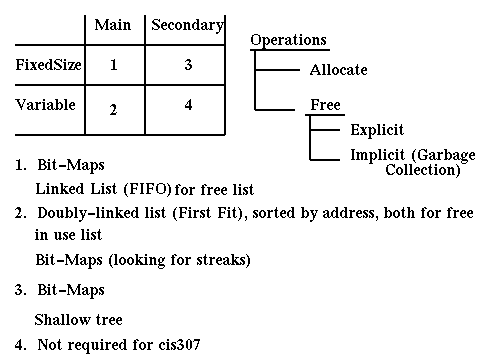 CIS 307: Storage Management
CIS 307: Storage Management
Storage Management is treated in Tanenbaum, Chapter 3. Here I want to
mention the topics that I expect students to know before getting into Virtual
Memory. Essentially, to study pages 74 to 88, and to review
algorithms for storage management. Be sure to study and understand:
- the 50% percent rule [The number of holes is 50% of the number of segments
in the case that allocation is of variable size blocks]
- the unused memory rule [f = k/(k+2), where f is fraction of space
lost to holes and k is the size of a hole, relative to the average
segment size], and
- the relation between memory
size and degrees of multiprogramming [if p is the probability that a process
is doing IO, and n is the degree of multiprogramming, then the CPU
utilization is 1 - p**n]
Storage Management Algorithms
The following picture describes possible storage management problems:

You should know how to use bit-maps for both fixed and variable
size blocks. You should know how to
use simple lists for fixed size blocks in main memory, and how to use shallow
trees in secondary memory (fixed size). [The Unix file system will give
us an example of such trees.] You should also know how to manage variable size
blocks in main memory using appropriate lists or the Buddy system.
Finally, you should have
some understanding of garbage collection and its algorithms.
Fragmentation
- Internal Fragmentation:
- Suppose you are in a paged Virtual Memory, with pages, say, of size p.
Then, if we are given a program of size S, we will require Ceiling(S/p) pages.
That is, we will waste
p*Ceiling(S/p) - S bytes
This is called Internal Fragmentation.
- External Fragmentation:
- Suppose you are in a Segmented Virtual Memory. Then storage is allocated in
variable size blocks. This results in the creation of holes of unallocated
memory that are smaller than requests for new segments. These holes are
essentially wasted storage (unless we compact storage). This we call
External Fragmentation. Tanenbaum (page 88) discusses the
Fifty percent Rule and the Unused Memory
Rule. It is easy to see using those results, that in most situations
external fragmentation is more wasteful than internal fragmentation.
In fact, assuming that we have n segments, each of size s, then
using the 50% rule
the number of holes is n/2 for a loss (external fragmentation) of n/2*h,
where h is the average size of a hole. The loss due
to internal fragmentation is on average n*p/2, where p is the size
of a page. Thus external fragmentation will be worse than internal
fragmentation whenever the average size of holes is greater than a page.
ingargiola.cis.temple.edu
 CIS 307: Storage Management
CIS 307: Storage Management CIS 307: Storage Management
CIS 307: Storage Management